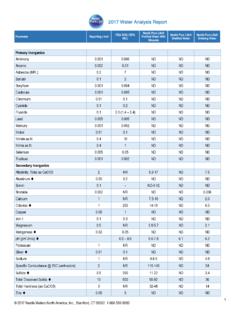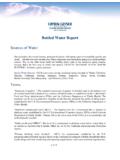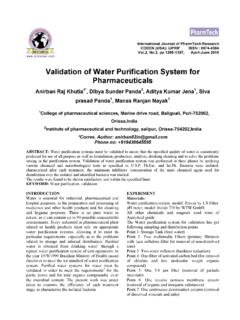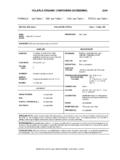Transcription of Soil Method Code Explainer 2010 GER - Soil, Plant Water ...
1 ASPAC soil Proficiency - soil Method code Explainer soil Method Code Explainer 2010 Page 1 of 6 soil Method CODE Explainer Summary details of Rayment and Lyons (2011) methods and Method codes commonly included in ASPAC Inter-laboratory Proficiency Programs for soils. Refer to Rayment and Lyons (2011) for more details on these and other methods. Note that Rayment and Lyons (2011) supersedes the previously used text of Rayment and Higginson (1992). References to these publications are: Rayment, and Higginson, (1992). Australian Laboratory Handbook of soil and Water Chemical Methods . 330 pp. Reed International Books Australia P/L, trading as Inkata Press, Port Melbourne. Rayment, and Lyons, (2011). soil Chemical Methods Australasia . 495+20 pp. CSIRO Publishing, Melbourne.
2 Code Method Comment 2A1 Air dry moisture content This Method is required to adjust soil chemical results based on air-dry samples to an oven-dry (105oC) basis. When the air-dry moisture content (M%) is known, the correction from air-dry to oven-dry is as follows: Oven-dry result = [Air-dry result x (100 + M%)] 100 3A1 Electrical conductivity (EC) of 1:5 soil / Water extract This test on milled air-dry sample at a soil / Water ratio of 1:5 for 1 h is suitable for use on all soils, irrespective of whether acidic or alkaline. It usually underestimates the soluble salt status of soils containing natural or added gypsum, particularly if 1% of gypsum is present. Such soils would have an EC of about 2 dS/m. soil EC x ( Method 3B1) approximates percent total soluble salts, while approximate soil ionic strength ( Method 3C1) at bar ( ) can be calculated as follows: = [ *EC1:5 ], where has units of mM, and EC1:5 has units of dS/m @ 25oC.
3 4A pH of 1:5 soil / Water suspension This test on milled air-dry sample involves mechanical shaking with deionised Water in a closed system for 1 h at a soil / Water ratio of 1:5 prior to pH measurement using calibrated electrodes, while stirring the soil / Water suspension. The Method is suitable for use on all soils, irrespective of whether acidic or alkaline. Values may be lower than expected on recently fertilised soils due to a temporary increase in soil solution ionic strength. 4B pH of 1:5 calcium chloride extract This pH test on milled air-dry sample is suitable for use on all soils, irrespective of whether acidic or alkaline. Values are usually unaffected by fertilisation prior to sampling, as changes to the soil s ionic strength is masked by the calcium chloride.
4 Code 4B1 indicates direct use of CaCl2, at a soil /solution ratio of 1:5, with mechanical shaking for 1 h prior to pH measurement using calibrated electrodes positioned in the unstirred supernatant after settling of the suspension. Code 4B2 provides a similar measurement outcome but relies on the addition of CaCl2 to a 1:5 soil / Water suspension to achieve CaCl2 prior to measurement of pH as for 4B1. Codes 4B3 and 4B4 are identical to 4B1 and 4B2, respectively, except the soil /CaCl2 suspensions are stirred during measurement. Method 4B5 codes for an MIR surrogate measurement. There is merit in separate use of both Water and calcium chloride to measure soil pH. 5A Chloride - 1:5 soil / Water extract Tests for Water -soluble chloride (Cl) on milled air-dry sample are suitable for use on all soils.
5 For Method 5A1, Cl- in clarified 1:5 soil / Water extracts is determined by potentiometric titration with AgNO3 in conjunction with an Ag/AgNO3 electrode array. For Method 5A2a, Cl- in clarified 1:5 soil / Water extracts is determined by an automated, continuous flow colorimetric procedure based on the formation in the presence of ferric ions and free thiocyanate ions of highly coloured ferric thiocyanate in proportion to the Cl- concentration. Method 5A2b is similar, except it pertains to the use of flow injection analysis (FIA). For 5A1 and 5A2 methods, it is assumed there are no chemical interferences of significance. Moreover, Method 5A2a has proven more precise than Method 5A1, particularly at soil concentrations ASPAC soil Proficiency - soil Method code Explainer Page 2 of 6 Code Method Comment <50 mg Cl/kg.
6 Other analytical finish options involve chemically-suppressed ion chromatography (5A3a), single-column electronically suppressed ion chromatography (5A3b), and direct measurement by ICPAES ( Method 5A4). The methodology specifies reporting results on an air-dry basis. 6A1 Organic carbon - W & B This measure of soil organic carbon (OCW&B; expressed as %C) usually yields a lower figure than the true total organic carbon value. The Method uses finely-milled air-dry sample. It involves wet oxidation by a dichromate-sulphuric acid mixture and relies only on heat of reaction. soil weight should take account of the expected concentration of OC, and it is expected that allowance will be made for positive soluble Cl- interference in soils containing > Cl.
7 The Method specifies reporting on an oven-dry (105oC) basis. Nowadays this Method is less preferred than 6B methods. 6B1 Total organic carbon - Heanes wet oxidation The chemical basis of this procedure is similar to that of Method 6A1, except that external heating on a hot-plate digestor is included. Expensive apparatus is not required, while interference from carbonate is negligible. Correction for positive Cl- interference in saline soils (> Cl) is recommended. The Method uses finely-milled air-dry sample, with weights varying with expected C concentrations. The Method specifies reporting as %C on an oven-dry (105oC) basis. 6B2 Total organic carbon - high frequency induction furnace (no soil pre-treatment) This Method for total soil OC involves production, purification and measurement of CO2 evolved when soil carbon is ignited in a stream of O2.
8 Because all C compounds are converted to CO2, the C from carbonates, charcoal, undecomposed wood, etc, will be included, as no soil pre-treatment is specified. In the volumetric sub- Method 6B2a, concentrated KOH solution is used to absorb the CO2 released. The difference between the original volume of gas in the burette and the volume produced after ignition equals the volume of CO2 evolved from the sample, after correction for gas temperature and pressure. Sub- Method 6B2b is similar to Method 6B2a, except the CO2 produced by ignition is measured via infrared / thermal conductivity detection. Both 6B2a and 6B2b use finely-milled air-dry sample, with weights varying with expected C concentrations. Surrogate estimates can be obtained by NIR ( Method 6B4a) or MIR ( Method 6B4b) reflectance spectroscopy.
9 The methods specify reporting as %C on an oven-dry (105oC) basis. 6B3 Total carbon - high frequency induction furnace (with prior physical removal of charcoal and chemical removal of carbonates) Following quantitative action / pre-treatment to account for or to physically remove (if present) charcoal and to chemically remove carbonate with excess 5% H2SO3 solution on a hot plate in a fume cabinet, the residual, re-dried soil sample is analysed for soil C by a suitable Method , preferably Method 6B2b. The Method involving carbonate removal and soil C analysis uses finely-milled air-dry sample, with weights varying with expected C concentrations. The Method specifies reporting as %C on an oven-dry (105oC) basis. 6G1 soil organic matter by loss-on-ignition This simple test involves the ignition of finely-milled air-dry sample initially to 105oC and then to 550oC.
10 One hundred times the difference in sample weight in grams between these two temperatures, , [100(Weight105C Weight550C)] = Loss on ignition550C (LOI550C), which is assumed to approximate % Organic Matter. 7A1 Total soil nitrogen - semi micro Kjeldahl, steam distillation. Method 7A1 provides a good estimate of total soil N in soils with little NO3: otherwise slightly lower apparent total soil N concentrations are likely. The Method initially involves semi-micro Kjeldahl digestion. Subsequently, NaOH solution is added to release NH3 by steam distillation. The NH3 released is quantitatively absorbed in dilute boric acid, with total soil N determined by titration with standard acid. The Method uses finely-milled air-dry sample and specifies reporting results as %N on an oven-dry (105oC) basis.








